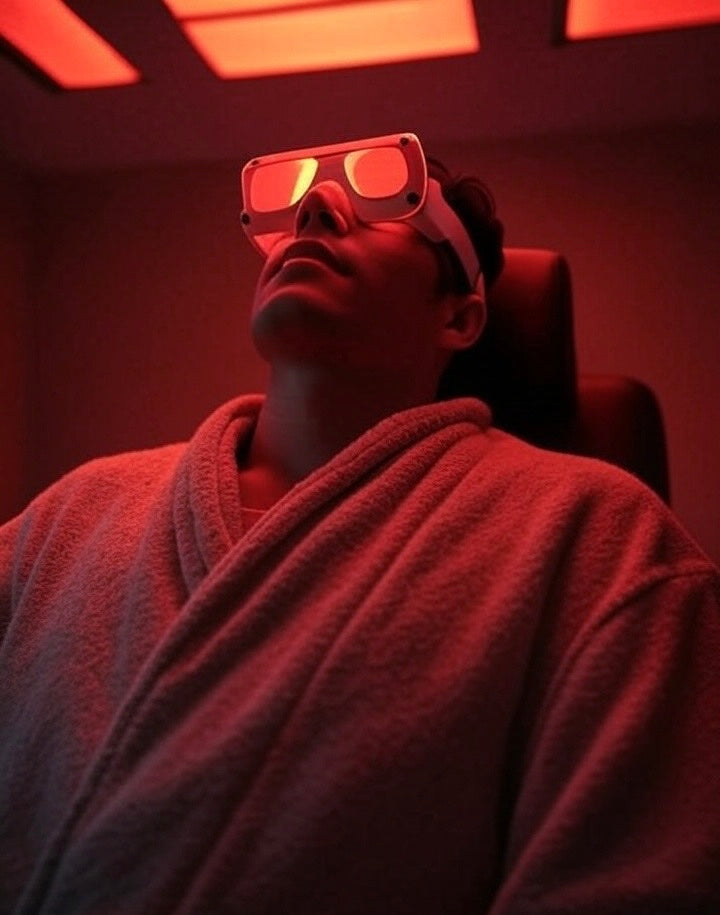Ever stared into your Red Light Therapy Panel wondering, “Can I just close my eyes?” Short answer: yes—but there’s more to it. Whether you’re using Red Light Therapy at home, lounging in red light therapy beds, or glowing solo, this guide will keep your eyes safe and your sessions blissful.

Understanding Red Light Therapy and Eye Safety
The Nature of Red Light Therapy (RLT)
What is Red and Near-Infrared (NIR) Light?
Red light therapy uses wavelengths between 600–700nm (red) and 800–900nm (near-infrared). These lie outside the ultraviolet spectrum, so there’s no tanning or burning involved.
It’s also non-ionising, which means it doesn’t damage DNA like UV rays do.
How RLT Works on a Cellular Level
Red light stimulates mitochondria—the energy centres inside your cells. This boosts ATP (adenosine triphosphate) production, enhancing your body’s ability to repair tissue, reduce inflammation, and improve circulation.
It’s a natural, non-invasive way to support internal recovery and rejuvenation.
Is Red Light Therapy Inherently Harmful to Eyes?
Distinguishing RLT from Harmful Light
Red light is not like UV rays or medical lasers. It doesn’t damage ocular tissue the way more intense or ionising radiation does.
It’s far less aggressive and non-ablative, meaning it doesn’t burn or cut.
Low Intensity vs. High Intensity Devices
Home-use panels typically emit low to moderate light intensity. However, full-body panels and red light therapy beds can be much stronger.
The brighter the light, the more care is needed—especially when it comes to eye exposure.
The Role of Device Quality and Certification
Cheap or uncertified devices might overexpose sensitive areas. Some may emit unintended wavelengths or lack adequate diffusion.
Always look for FDA-cleared or CE-certified products, especially if you’re using red light therapy at home.
Protecting Your Eyes During Red Light Therapy Sessions
When Eye Protection is Recommended or Necessary
High-Intensity Devices and Full-Body Panels
Panels that light up an entire room may be too intense for unprotected eyes. In these cases, using goggles is advised to avoid prolonged retinal exposure.
Sensitivity to Light and Discomfort
Some individuals are naturally photosensitive. If red light leads to watery eyes, headaches, or eye strain, consider protective gear for comfort.
Pre-Existing Eye Conditions
Those with glaucoma, macular issues, or who take photosensitising medication should consult a professional before beginning. Direct exposure could worsen existing conditions.
Specific Wavelengths
Near-infrared (NIR) light penetrates deeper into tissues. While it’s generally safe, eye shielding is wise during extended or close-range use.
Can Simply Closing Your Eyes Suffice?
Advantages of Eye Closure
Yes—you can often just close your eyes. Doing so blocks direct light, prevents glare, and helps you relax.
It’s a simple and natural way to protect your vision, especially during facial sessions or low-intensity treatments.
Limitations of Eye Closure
However, light can still pass through thin eyelids. If your panel is strong or close to your face, closing your eyes may not fully shield your retinas.
When Eye Closure is Generally Acceptable
For low-powered home panels placed at a reasonable distance, simply closing your eyes is usually enough. Just avoid staring directly into the light source.
Types of Eye Protection for RLT
Specialised RLT Goggles or Masks
Invest in goggles made for red and NIR light. These are designed to block specific wavelengths while allowing you to rest comfortably during sessions.
In-Built Device Protection Features
Some modern devices come with built-in light diffusers, automatic timers, or reduced-glare settings. Check the manual for safety options.
Why Regular Sunglasses Are Not Enough
Standard sunglasses are made to block UV and visible light—not red or near-infrared. They often fit loosely and won’t seal light out entirely.
Red Light Therapy and Eye Health: Potential Benefits

Emerging Research on Ocular Benefits
Improving Mitochondrial Function in Retinal Cells
Early studies suggest red light may boost mitochondrial performance in retinal cells. This could support overall eye health and energy metabolism.
Potential for Age-Related Macular Degeneration and Dry Eye
Initial findings point to improvements in macular function and relief from dry eye symptoms. Still, more research is needed before clinical applications are confirmed.
Protecting Against Oxidative Stress
Red light may reduce oxidative stress in the eyes. This could slow the progression of age-related issues like eye fatigue and vision decline.
Important Considerations for Eye-Specific Treatments
The Importance of Professional Guidance
Always consult with an optometrist if you’re targeting eye-specific conditions. Red light therapy should complement, not replace, medical care.
Not a Self-Treatment for Eye Conditions
Although red light offers promise, it’s not meant for diagnosing or curing eye diseases. Use it with medical supervision only.
Adhering to Manufacturer’s Instructions
Follow your panel’s user manual closely. Settings, distances, and exposure times vary greatly between models.
Takeaways
-
Yes, you can close your eyes—but the intensity of the light matters
-
For most home panels, eye closure is safe enough
-
If discomfort occurs or the light is too strong, use proper goggles
-
Some research shows red light may benefit eye health
-
Always consult a professional and follow product guidelines
Conclusion
So—can you just close your eyes during red light therapy? For most people using moderate-intensity panels, the answer is yes.
However, if you’re using full-body beds, extra-bright devices, or have existing eye concerns, take care. Add goggles, follow instructions, and enjoy the glow safely.
With the right approach, red light therapy can support your wellbeing—without putting your eyes at risk.






